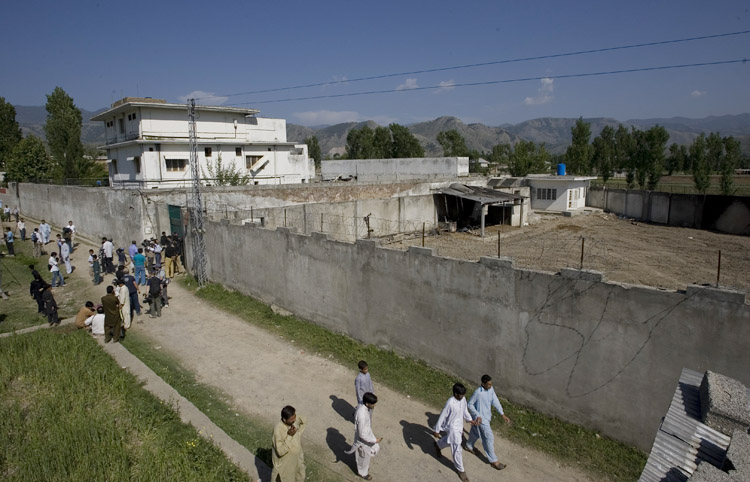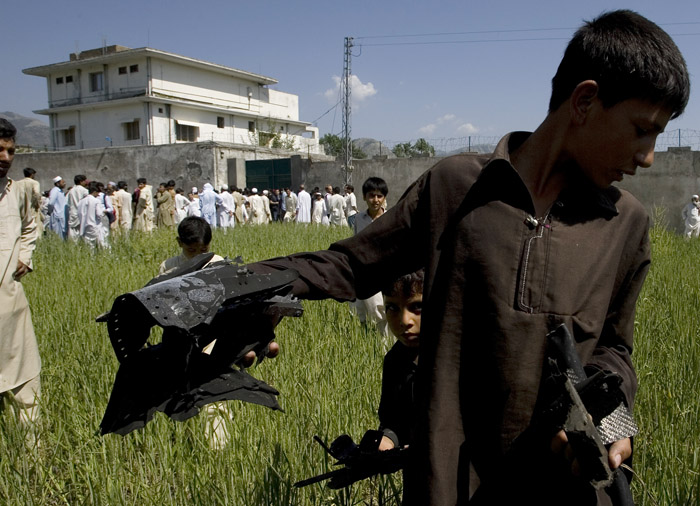WASHINGTON — White House: bin Laden unarmed during assault â¨Nancy Benac,Associated Press
WASHINGTON — Osama bin Laden was unarmed when he was confronted by U.S. commandos at his Pakistani hideout but tried to resist the assault, the White House said today as new details emerged about the audacious raid that killed the world’s most wanted terrorist.
The White House said it was considering whether to release photos that were taken of bin Laden after he was killed but was concerned that the photos were “gruesome” and could be inflammatory.
Other details that emerged on Tuesday, according to U.S. officials: One of bin Laden’s wives tried to rush the commandos and was shot in the leg. High temperatures caused a lumbering helicopter carrying the raiders to make a hard landing. And as Navy SEALs swept through the compound, they handcuffed those they encountered with plastic zip ties and pressed on in pursuit of their target, code-named Geronimo.
Once bin Laden had been shot, they doubled back to move the prisoners away from the compound before blowing up the downed helicopter.
The fuller picture of the high-stakes assault emerged as U.S. officials weighed whether to release video and photos of bin Laden, who was killed with a shot above his left eye.
Sen. Dianne Feinstein, who chairs the Senate Intelligence Committee and revealed some of the new details about the raid, said she’d known about the suspected bin Laden compound since last December — offering rare evidence that Washington can indeed keep a blockbuster secret.
President Barack Obama made plans to go to ground zero in New York on Thursday to mark the milestone of bin Laden’s demise and to remember the dead of the Sept. 11, 2001, attacks.
White House counterterrorism adviser John Brennan said the U.S. was scouring items seized in the raid on bin Laden’s compound in Abbottabad, Pakistan — said to include hard drives, DVDs, a pile of documents and more — that might tip U.S. intelligence to al-Qaida’s operational details and perhaps lead to the presumed next-in-command, Ayman al-Zawahri.
As for publicly releasing photos and video, Brennan said in a series of appearances on morning television. “This needs to be done thoughtfully,” with careful consideration given to what kind of reaction the images might provoke.
At issue were photos of bin Laden’s corpse and video of his swift burial at sea. Officials were reluctant to inflame Islamic sentiment by showing graphic images of the body. But they were also anxious to address the stories already building in Pakistan and beyond that bin Laden was somehow still alive.
In a move that could increase pressure for the release of photos, Afghan Taliban spokesman Zabihullah said talk of bin Laden’s death was “premature,” adding that the U.S. had not presented “convincing evidence,” the SITE Intelligence Group reported.
Obama, who approved the extraordinarily risky operation and witnessed its progression from the White House Situation Room, his face heavy with tension, reaped accolades from world leaders he’d kept in the dark as well as from political opponents at home. Pakistan, however, called the raid “unauthorized” Tuesday and it shouldn’t serve as a precedent for future actions.
CIA Director Leon Panetta, in interviews with Time and PBS’ “Newshour,” sketched the scene in the Situation Room as the tense final minutes of the raid played out.
“Once those teams went into the compound,” he told PBS, “I can tell you there was a time period of almost 20 or 25 minutes that we really didn’t know just exactly what was going on.”
Then, Panetta told Time, when Adm. William McRaven, head of the Joint Special Forces Command, reported that the commandos had identified “Geronimo” — the code name for bin Laden — “all the air we were holding came out.”
And when the helicopters left the compound 15 minutes later, Panetta said, the room broke into applause.
Carney filled in details about the assault, saying that bin Laden did resist the commandos, although he was not armed. One of bin Laden’s wives, Carney said, was in the room and tried to charge at the U.S. assaulters.”
Monday night, Republican and Democratic leaders gave Obama a standing ovation at an evening White House meeting that was planned before the assault but became a celebration of it, and an occasion to step away from the fractious political climate.
The episode was an embarrassment, at best, for Pakistani authorities as bin Laden’s presence was revealed in their midst. The stealth U.S. operation played out in a city with a strong Pakistani military presence and without notice from Washington. Questions persisted in the administration and grew in Congress about whether some elements of Pakistan’s security apparatus might have been in collusion with al-Qaida in letting bin Laden hide in Abbottabad.
Brennan asked the question that was reverberating around the world: “How did Osama bin Laden stay at that compound for six years or so and be undetected?”
“We have many, many questions about this,” he said. “And I know Pakistani officials do as well.” Brennan said Pakistani officials were trying to determine “whether there were individuals within the Pakistani government or military intelligence services who were knowledgeable.” He questioned in particular why bin Laden’s compound hadn’t come to the attention of local authorities.
Feinstein, for her part, said Congress may consider docking the almost $1.3 billion dollars in annual aid to Pakistan if it turns out the Islamabad government knew bin Laden’s whereabouts.
In an article published Tuesday by The Washington Post, Pakistani President Asif Ali Zardari denied suggestions his country’s security forces may have sheltered bin Laden, and said their cooperation with the United States helped pinpoint his whereabouts.
As Americans rejoiced, they worried, too, that terrorists would be newly motivated to lash out. In their wounded rage, al-Qaida ideologues fed that concern. “By God, we will avenge the killing of the Sheik of Islam,” one prominent al-Qaida commentator vowed. “Those who wish that jihad has ended or weakened, I tell them: Let us wait a little bit.”
In that vein, U.S. officials warned that bin Laden’s death was likely to encourage attacks from “homegrown violent extremists” even if al-Qaida is not prepared to respond in a coordinated fashion now.
U.S. officials say the photographic evidence shows bin Laden was shot above his left eye, blowing away part of his skull.
He was also shot in the chest, they said. This, near the end of a frenzied firefight in a high-walled Pakistani compound where helicopter-borne U.S. forces found 23 children, nine women, a bin Laden courier who had unwittingly led the U.S. to its target, a son of bin Laden who was also slain, and more.
Bin Laden could have lived at the fortified compound for up to six years, putting him far from the lawless and harsh Pakistani frontier where he had been assumed to be hiding out.
They said SEALs dropped down ropes from helicopters, killed bin Laden aides and made their way to the main building.
U.S. officials said the information that ultimately led to bin Laden’s death originally came from detainees held in secret CIA prison sites in Eastern Europe. There, agency interrogators were told of an alias used by a courier whom bin Laden particularly trusted.
It took four long years to learn the man’s real name, then years more before investigators got a big break in the case, these officials said.
Sometime in mid-2010, the courier was overheard using a phone by intelligence officials, who then were able to locate his residence — the specially constructed $1 million compound with walls as high as 18 feet topped with barbed wire.
U.S. counterterrorism officials considered bombing the place, an option that was discarded by the White House as too risky, particularly if it turned out bin Laden was not there.
Panetta told Time that a “direct shot” with cruise missiles was still under consideration as late as Thursday but was ruled out because of the possibility of “too much collateral” damage. Waiting for more information also was a possibility.
Ultimately, Obama signed an order on Friday for the team of SEALs to chopper onto the compound under the cover of darkness.
In addition to bin Laden, one of his sons was killed in the raid, Brennan said. Bin Laden’s wife was shot in the calf but survived, a U.S. official said. Also killed were the courier, and the courier’s wife and brother, U.S. intelligence officials believe.
Feinstein, asked if the information gleaned from high-value detainees in the CIA’s former secret prisons had proved the worth of such tactics, said “nothing justifies the kind of procedures used.”
Some people found at the compound were left behind when the SEALs withdrew and were turned over to Pakistani authorities who quickly took over control of the site, officials said. They identified the trusted courier as Kuwaiti-born Sheikh Abu Ahmed, who had been known under the name Abu Ahmed al-Kuwaiti.
Within 40 minutes, the operation was over, and the SEALs flew out — minus the helicopter that had to be destroyed. Bin Laden’s remains were flown to the USS Carl Vinson, then lowered into the North Arabian Sea.
Bin Laden’s death came 15 years after he declared war on the United States. Al-Qaida was also blamed for the 1998 bombings of two U.S. embassies in Africa that killed 224 people and the 2000 attack on the USS Cole that killed 17 American sailors in Yemen, as well as countless other plots, some successful and some foiled.
Send questions/comments to the editors.



